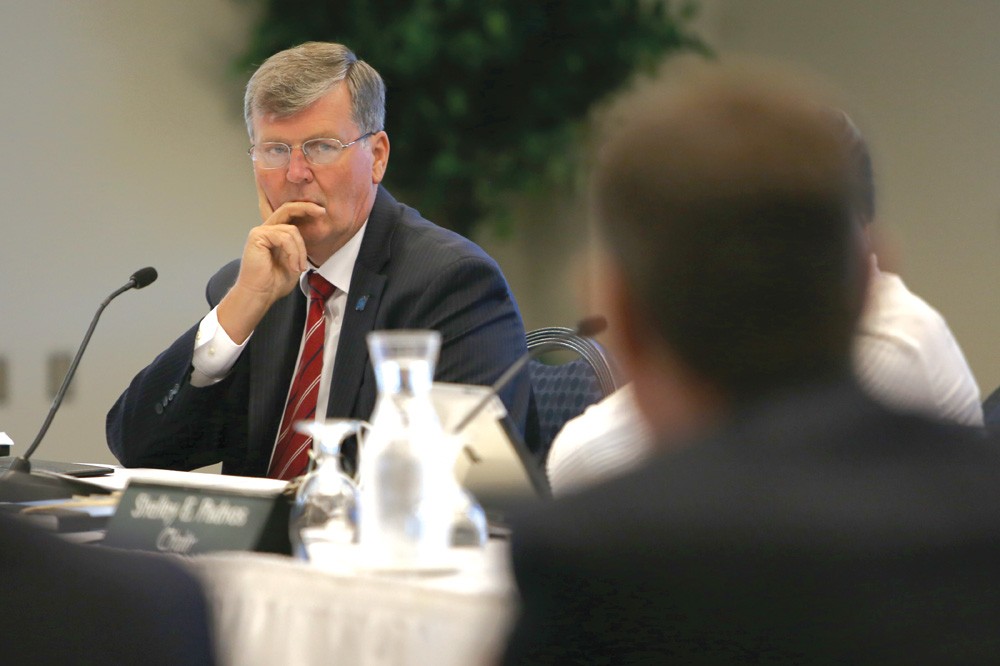GV board approves budget, increases tuition

GVL / Robert Mathews President T. Haas during the Friday, July 12th Board of Trustees meeting.
Jul 12, 2013
Grand Valley State University’s Board of Trustees unanimously approved a 3.7 percent increase in tuition rates for the 2013-2014 school year during its meeting on July 12.
“I’m pleased to recommend one of the smaller tuition increases in the past two decades, still I recognize that any increase puts additional pressure on students and their families,” said Jim Bachmeier, vice president for finance and administration.
The rate increase equals out to $188 per semester for incoming freshmen with similar increases for upper division and out of state students. Graduate students will see increases of $19 to $24 per credit hour.
“Grand Valley has held cost of operations to the rate of inflation for at least the last two decades,” Bachmeier said. “However, while our costs have remained flat, the revenue formerly received from the state continues to drop as a percentage of our budget.”
Grand Valley is set to receive over $57 million in state appropriations, making up about 19.4 percent of total revenues for the 2013-2014 budget. Last year, state appropriations totaled over $55 million and accounted for 19.5 percent of GVSU’s total revenue.
“While we are scheduled to receive an increase from the state in state appropriations based on our high performance metrics, we unfortunately have not seen the needed structural reform in overall university support,” Bachmeier said. “As a result our total appropriation this year is still $503 per student below what it was five years ago.”
If Grand Valley were to receive funding similar to other universities in the region, its annual appropriation would be $23 million higher than what it actually is, Bachmeier said.
President Thomas Haas was pleased that Grand Valley was set to receive $2.3 million for its performance, but was less enthusiastic with the university’s base budget appropriation from the state.
“I am so pleased that the governor and others are identifying performance as a key to how we need to allocate dollars,” he said. “The real money though, ladies and gentlemen, is in the base and that is almost untouchable.”
Haas also said the one-time monies allocated for performance are barely keeping track with inflation.
“Our performance metrics places us in the top of national peers, yet our state appropriation is virtually last in the nation,” Haas said. “Our base budget fundamentally reflects the past. I don’t want to be in the past. It doesn’t reflect today’s reality of enrollment, graduation rates or performance metrics.”
State policies don’t factor in enrollment when considering appropriations, and Haas believes legislators need to take a more rational approach to allocating money.
“I think that our students and their families are being disadvantaged and in a way subsidizing others because of the current policy,” he said. “With an increase in enrollment, you see a decrease in your per student allocation. Or another way to look at it, if you cut your student numbers you get an increase or reward in your per student allocation. I find that to be interesting Lansing math.”
Grand Valley’s new budget is based on a stable enrollment of almost 25,000 students and projects expenditures of $333 million, which includes institutionally funded financial aid.
“The semester tuition rate of $5,227 will be reduced by an average of almost $2,000 per semester in average gift and grant aid leaving an average net cost of about $3,300,” Bachmeier said.
About 61 percent of state funding was allocated to support students through financial aid, with the remaining $22 million allocated to institutional funds like construction and debt services, utilities services and capital maintenance and repairs.
“Not a single salary dollar at this university has any taxpayer record behind it anymore,” Bachmeier said.
The approved budget also includes a 2 percent increase in wages for faculty and staff members.

























